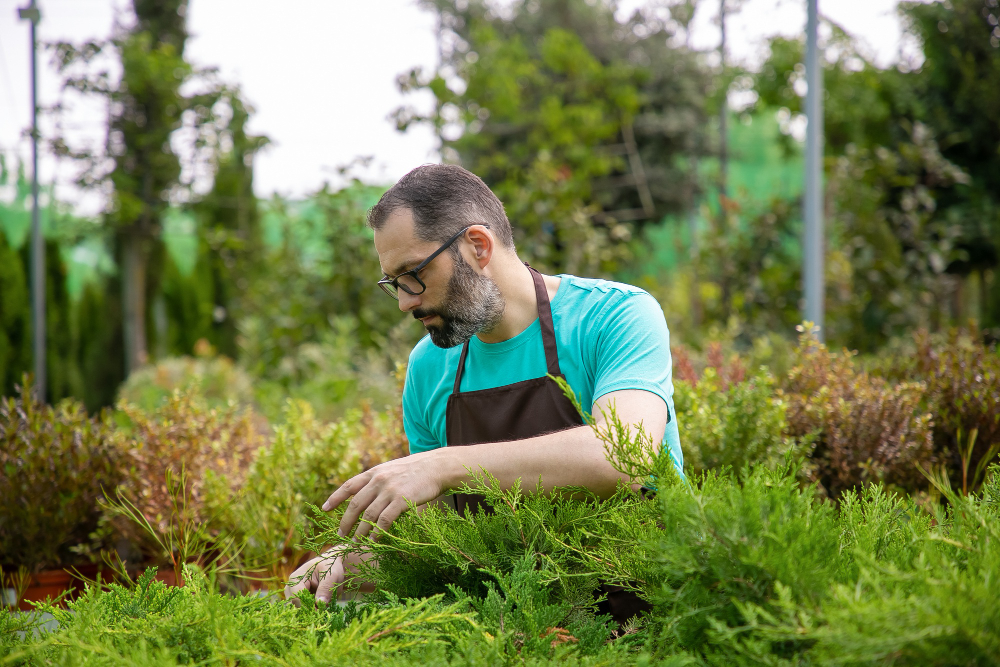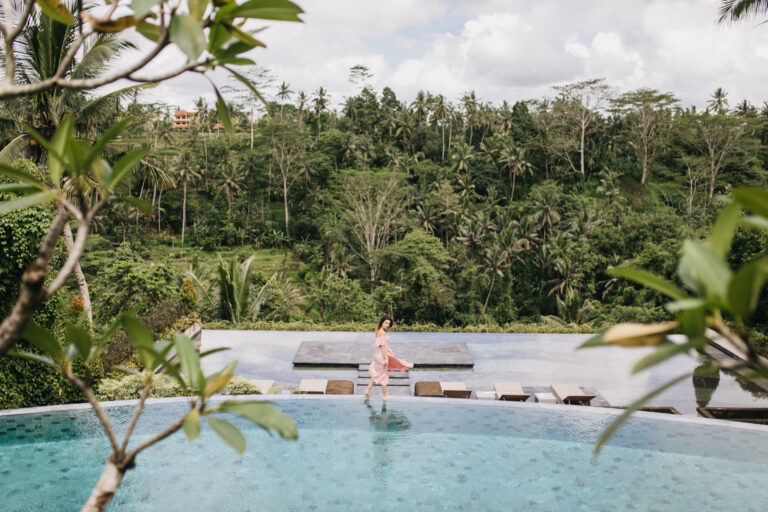Sustainable landscaping is a trending topic in the world of outdoor design and gardening. With more and more people becoming environmentally conscious, the demand for eco-friendly outdoor spaces is on the rise.
A recent study shows that 76% of Americans agree that taking care of the environment is important, and what better way to do so than by creating an eco-friendly outdoor oasis?
By using sustainable landscaping practices, you can not only reduce your carbon footprint, but also create a beautiful and functional outdoor space that benefits the environment.
In this article, we will explore the basics of sustainable landscaping and how you can create your very own eco-friendly oasis.
Choosing the Right Plants
Native plants are an essential component of creating an eco-friendly outdoor oasis. These plants are indigenous to the local ecosystem and have evolved to thrive in the specific climate and soil conditions. There are numerous benefits to incorporating native plants into your outdoor space.
Some of the benefits of incorporating them:
- Native plants require less water and maintenance once established, making them a more sustainable choice for your outdoor space.
- They provide food and habitat for local wildlife, including birds, bees, butterflies, and other pollinators.
- By using native plants, you can help preserve the local ecosystem and protect biodiversity.
- Native plants are adapted to the local climate and soil conditions, making them more resilient to extreme weather events such as droughts or floods.
- They can help reduce soil erosion and filter pollutants from the air and water, improving overall environmental health.
Here are some tips for incorporating edible plants into your landscape:
- Start small: Choose a few plants that are easy to grow and maintain. This will help you get a feel for what works best in your space and how much time and effort you’ll need to invest.
- Consider your climate: Choose plants that are well-suited to your climate. This will ensure that they thrive and produce a good yield.
- Mix it up: Incorporate different types of plants for a variety of colors, textures, and flavors. This will also help you maximize your space and yield.
- Think about placement: Consider where you’ll be placing your plants in your landscape. Some plants, like tomatoes, need full sun, while others, like lettuce, do better in partial shade.
- Get creative: Don’t be afraid to get creative with your plant placement. For example, you could use trellises to grow climbing plants or plant herbs in a vertical garden.
- Keep it tidy: Make sure to keep your edible plants well-maintained and tidy. This will help prevent pests and disease and ensure that you have a healthy yield.
Water Conservation
Water is a precious resource that should be conserved as much as possible. Water-wise techniques are ways in which we can reduce our water consumption and waste.
Here are some examples of water-wise techniques:
- Install low-flow fixtures: Low-flow showerheads, faucets, and toilets can significantly reduce water usage while still maintaining adequate water pressure. These fixtures limit the amount of water that flows through them, helping to reduce water waste.
- Fix leaks promptly: A dripping faucet or running toilet can waste a significant amount of water over time. It is important to fix any leaks as soon as they are detected to avoid wasting water.
- Use water-efficient appliances: There are a variety of appliances on the market that are designed to use water more efficiently. These include dishwashers and washing machines that have water-saving features.
- Water plants in the morning or evening: Watering plants during the hottest part of the day can cause water to evaporate quickly, resulting in wasted water. Watering plants in the morning or evening when temperatures are cooler can help to reduce water waste.
- Use mulch in gardens: Mulch helps to retain moisture in the soil, reducing the need for frequent watering. This can help to conserve water and keep plants healthy.
By implementing these water-wise techniques, we can significantly reduce our water consumption and waste, helping to preserve this valuable resource for future generations.
Water is a precious resource and it is important that we use it wisely.
Here are some tips and information on efficient irrigation systems to help reduce water usage:
Efficient Irrigation Systems:
- Drip irrigation systems: These systems deliver water directly to the roots of plants, greatly reducing the amount of water that is wasted through evaporation or runoff.
- Smart irrigation controllers: These controllers use weather data and soil moisture sensors to automatically adjust the watering schedule and amount based on the needs of the plants.
- Rainwater harvesting systems: These systems collect and store rainwater for later use in irrigation, reducing the reliance on municipal water supplies.
Tips for Reducing Water Usage:
- Mulch around plants: Applying a layer of mulch around plants can help retain moisture in the soil, reducing the need for watering.
- Water during the early morning or late evening: Watering during the middle of the day can result in a significant amount of water being lost to evaporation, so it is best to water when the sun is not as strong.
- Use a broom, not a hose: Rather than using a hose to clean driveways or sidewalks, use a broom to sweep them clean.
- Fix leaks promptly: A leaky faucet or sprinkler can waste a surprising amount of water, so be sure to fix any leaks as soon as they are discovered.
Green Landscaping Practices
Green landscaping practices are all about taking care of your lawn and garden while preserving the environment. One way to achieve this is by using organic fertilizers and natural pest control methods. Lawn care services that specialize in eco-friendly practices can help ensure that your outdoor space is not only beautiful but also sustainable.
Creating a natural habitat for wildlife can be a rewarding experience that benefits both the environment and the animals that call it home.
Here are some steps you can take to create a natural habitat for wildlife:
- Research the local wildlife: Before you begin creating a habitat, it’s important to understand the needs and behaviors of the local wildlife. This will help you design a habitat that meets their specific requirements.
- Choose native plants: Native plants are well adapted to the local climate and provide food and shelter for wildlife. They are also low maintenance and don’t require as much water as non-native plants.
- Provide water: Water is essential for wildlife, especially during hot and dry periods. You can create a natural water source by installing a pond or birdbath, or by allowing a natural stream or river to flow through your property.
- Create shelter: Wildlife needs shelter to protect themselves from predators and the elements. You can provide shelter by planting shrubs and trees, creating brush piles, or building birdhouses and bat boxes.
- Avoid pesticides: Pesticides are harmful to wildlife and can disrupt the natural balance of your habitat. Instead, use natural methods to control pests, such as companion planting or introducing natural predators.
- Maintain your habitat: Creating a natural habitat requires ongoing maintenance to ensure that it remains healthy and sustainable. This includes regular watering, pruning, and weeding, as well as monitoring the habitat for signs of disease or pests.
Eco-Friendly Hardscaping
Permeable pavers and other sustainable materials are becoming increasingly popular in construction and landscaping projects. These materials are designed to reduce the impact of development on the environment. Here are some benefits of using permeable pavers and other sustainable materials:
- Water management: Permeable pavers allow water to infiltrate the ground, reducing runoff and minimizing erosion. This helps to recharge groundwater and reduces the risk of flooding.
- Reduced heat island effect: Traditional paving materials can absorb and retain heat, leading to a phenomenon known as the “heat island effect.” Permeable pavers are designed to reflect more sunlight, reducing the amount of heat absorbed by the pavement and surrounding areas.
- Improved air quality: Permeable pavers can help reduce the amount of pollutants that enter the air and water. This is because the pavers trap pollutants and prevent them from entering the groundwater or being carried away by runoff.
- Lower maintenance costs: Permeable pavers and other sustainable materials require less maintenance than traditional materials. They are also more durable and can withstand heavy use and extreme weather conditions.
- Aesthetically pleasing: Permeable pavers come in a variety of colors and styles, allowing them to be used in a wide range of projects. They can be used to create unique and visually appealing designs that are also environmentally friendly.
Conclusion
Creating an eco-friendly outdoor oasis is a great way to make your home more sustainable. When you incorporate sustainable landscaping practices, you not only benefit the environment but also create a beautiful outdoor space that you can enjoy for years to come. By working with a professional deck contractor, you can ensure that your outdoor space is not only sustainable but also functional and stylish.
So if you’re thinking of creating an outdoor oasis, be sure to consider sustainable landscaping options and hire a reputable deck contractor to bring your vision to life. With the right approach, you can create an outdoor oasis that is both beautiful and sustainable, and you’ll feel good knowing that you’re doing your part to protect the environment.
Also, if you are located in Des Moines and looking for professional help to create an eco-friendly oasis in your yard, consider hiring a des moines landscaping company that specializes in sustainable practices. With their expertise and knowledge of the local environment, they can help you design and implement a landscape that is both beautiful and environmentally conscious.
Share your own sustainable landscaping tips and ideas with us.
Have you found a way to reduce your water usage?
We want to know!
What tips or ideas do you have to share?





